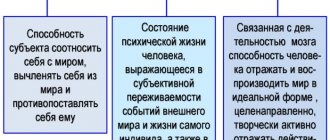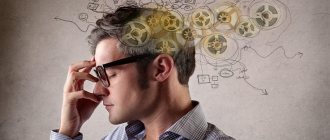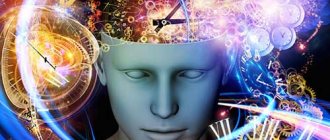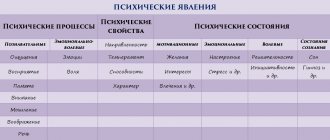Definition of the concept of “consciousness” in psychology
Consciousness in psychology is a set of interconnected information reflected in a person’s memory about the surrounding world and human life, which also includes the awareness of the person himself in this world and his attitude towards society, people and the whole world as a whole.
Consciousness is formed in the process of human interaction with the environment, as well as in the process of learning and communicating with people.
The processes of the human body through which consciousness is formed can be called the following processes:
- sensation;
- perception;
- thinking;
- imagination;
- memorization.
If any of the above processes are disrupted, this can lead to various disruptions in the functioning of consciousness and its disorders. A person, unlike an animal, can be aware of himself and also engage in self-knowledge.
Thanks to the presence of his “I” in the consciousness, a person can set goals dictated not only by instincts and physiological needs (as is the case with animals), but also goals formed thanks to individual, abstract thinking based on social, scientific and everyday knowledge.
8.1. General definition of the category “consciousness”
The considered forms of mental reflection in their development necessarily create the highest form of mental reflection - consciousness,
inherent only to man.
From a philosophical point of view, the objective necessity of the emergence of consciousness has been shown for a long time. Nature creates human consciousness with necessity, since it is in human consciousness that nature realizes itself.
This is the highest level of goal setting and realization of self-development in life.
In this regard, one cannot help but recall the thought of the famous Soviet philosopher E.V. Ilyenkov: “It is in man
Nature, in the most self-evident way, performs the very action that we are accustomed to calling “thinking.”
In man, in his person, nature itself thinks...
In man, nature thinks itself, realizes
itself
, feels itself, acts
on itself”
[30, p. thirty].
For the purpose of methodological analysis, let us consider some definitions of consciousness.
Consciousness
– (English
consciousness) -
the ultimate abstraction and at the same time the “eternal” problem of philosophy, psychology, sociology.
Discussion of the problem of consciousness in a philosophical vein is a discussion of the fundamental aspects of human existence: the richness and diversity of human relationships to reality; the ability perfectly
reproduce reality;
knowledge
about the world, including an idea of the role and place of man in it, about the “meaning of life”; about human freedom, his sense of guilt and responsibility; about the direction of the world process, etc. However, consciousness does not coincide with the conscious content.
And then the content and characteristics of consciousness are revealed on two pages of printed text [15, p. 517-519].
An equally broad definition of consciousness is given in another source. Below is just a fragment of the definition.
Consciousness,
one of the basic concepts of philosophy, psychology and sociology, denoting the highest level of mental activity of a person as a social being.
The uniqueness of this activity lies in the fact that the reflection of reality in the form of sensitive and mental images anticipates the practical actions of a person, giving them a purposeful character. This determines the creative transformation of reality, initially in the sphere of practice, and then on the internal plane in the form of representations, thoughts, ideas and other spiritual phenomena that form the content of consciousness, which is imprinted in cultural products (including language and other sign systems), acquiring the form of an ideal
and acting as knowledge.
Consciousness also includes an axiological, value aspect, which expresses the selectivity of consciousness, its orientation towards values developed by society and accepted by the subject of consciousness - philosophical, scientific, political, moral, aesthetic, religious, etc. Consciousness includes the attitude of the subject both to these values and to oneself, thereby acting in the form of self-awareness
, which also has a social nature. A person’s knowledge of himself becomes possible thanks to his ability to correlate his attitudes and orientations with the life values of other people, and the ability to take these positions in the process of communication. The dialogical nature of consciousness is also indicated by the term: “co-knowledge,” i.e., knowledge that is acquired together with others.
In psychology, consciousness is interpreted as a special, highest level of organization of the mental life of a subject, separating himself from the surrounding reality, reflecting this reality in the form of mental images that serve as regulators of purposeful activity. The most important function of consciousness is the mental construction of actions and anticipation of their consequences, control and management of the behavior of the individual, his ability to be aware of what is happening both in the environment and in his own spiritual world. Consciousness is the relationship of the subject to the environment, which means the inclusion in the act of consciousness of both the subject’s entire life in its uniqueness and originality, and his direct experience of the system of his relations to reality [95, p. 622-624].
Brief definitions include the following. Consciousness
– the highest form of mental reflection, arising only in human society and mediated by various “psychological tools” (language, other sign systems, so-called perceptual standards, etc.) [88, p. 7].
Consciousness
– this is a very special form of reflection of reality, which arises and is embodied only in the joint production and speech activities of people, in their communication and interaction with each other [32, p. 170].
Consciousness
is a property of highly organized matter - the human brain, a product and a necessary side of labor activity and social life existing on its basis [58, p. 52].
Consciousness
– the highest form of generalized reflection of objective stable properties and patterns of the surrounding world, characteristic of humans, as well as the creation of an internal model of the external world, as a result of which knowledge and transformation of the surrounding reality are possible [89, p. 168].
In conclusion, we present Lenin’s definition of consciousness as a property of that highly organized piece of matter that we call the human brain.
As we see from these definitions, the category of consciousness is perhaps the most complex and multifaceted in psychology and it is quite difficult to define its essence in brief definitions. Nevertheless, these definitions make it possible to identify stable characteristics that are inherent in the category of consciousness and define it. Thus, consciousness:
• the highest form of mental reflection;
• property of highly organized matter - the human brain;
• arises only in human society;
• the highest level of mental activity of a person as a social being;
• the highest level of organization of the mental life of a subject, distinguishing himself from the surrounding reality, reflecting this reality in the form of mental images that serve as regulators of purposeful activity;
• ideal form of reflection of the surrounding world;
• is embodied only in the joint production and speech activities of people, in their communication and interaction.
By synthesizing these characteristics, in line with the presented methodological approach, we can offer the following definition of individual human consciousness.
Consciousness is the highest form of development of the psyche, a property of highly organized matter - the human brain, which consists in the active reflection by the subject of the surrounding world in ideal images (concepts), on the basis of which a picture of the world that is inalienable from him is created, the identification of the Self as a unique individuality, the possibility of cognition and self-knowledge (reflection ) for the regulation of purposeful behavior, activity, communication and adaptation in the surrounding world and society.
Functions of consciousness and properties
Consciousness performs the most important functions in human life. With the help of consciousness and the interaction of its constituent structures, a person analyzes the information received from the outside, evaluates it and processes this information to make all kinds of decisions in the process of life.
Consciousness has the following functions:
- Cognitive (consciousness is capable of not only subjectively reflecting the world around us, but also cognizing it through the analysis of accumulated information and knowledge gained as a result of the life of both an individual and all previous generations).
- Goal-setting (based on the material and spiritual needs of a person, consciousness has the ability to set goals that contribute to the development of the person himself, as well as the transformation of the external world).
- Axiological (a person can evaluate what is happening around him, as well as the activities of other people through the prism of his beliefs and needs that exist in his mind).
- Creative (a person is able not only to understand the world around him, but also to create new material and social benefits that develop and improve his life).
- Reflexive (the ability to analyze oneself and the content of one’s own consciousness).
- Spiritual (formation of the worldview and attitude of the individual to the social sphere of life).
Activity
Consciousness functions in constant activity (even in sleep it continues to work, partially processing information received during the day).
This activity implies not only the physical characteristics of the organism, but also the constant movement of mental, goal-setting activity of consciousness, aimed at achieving certain goals related to human activity, the transformation of his personality and the external world.
Intentionality
The main property of consciousness is its ability to be directed at a specific object in the process of mental activity. Thanks to the constant interaction of a person’s own “I” with individual elements of consciousness, the process of its development and the fulfillment of all existing functions of consciousness occur.
Forms and types
Consciousness in psychology is a dual concept that can mean such forms of consciousness as social and individual consciousness.
Social consciousness is the totality of knowledge, ideas and views inherent in a particular society or all of humanity at a certain stage of its development.
Structure of consciousness in psychology
Individual consciousness is the totality of knowledge, ideas and views of an individual.
Both forms of consciousness influence each other throughout their entire existence. As a result of this interaction, the development of both social and individual consciousness of all people occurs.
Depending on the degree of clarity of individual consciousness, several types are distinguished:
- Clear (when a person thinks actively, answers questions clearly and reacts adequately to surrounding events).
- Unclear (when a person shows indifference towards himself, and he answers the questions posed slowly and not always correctly).
- Stupor (if a person cannot independently navigate in space and reacts slowly to external stimuli).
- Dullness (if a person is almost always in hibernation, from which he can only be brought out for a short time).
- Coma (when a person is in deep sleep and does not react to anything).
- Delusion (when a person perceives reality in a distorted form and reacts inadequately to external events).
- Hallucinations (if a person experiences auditory or visual distortions of information perceived from outside).
Origin and essence of consciousness. Reflection and Consciousness
In the history of the development of philosophical knowledge, there are 3 points of view about the origin of consciousness:
- Religion assumes that consciousness is a manifestation of an immaterial substance, the soul does not depend on the brain and is capable of independent existence, it is immortal and eternal;
- Idealists believe that consciousness is primary in comparison with matter, it is the independent essence of the original activity;
- Materialists rely on the idea that consciousness is a subjective image of the objective world.
Dialectical materialism approaches the question of the origin of consciousness historically and asserts that all matter has the property of reflection.
Reflection is the ability of material systems to reproduce in themselves the properties of other material objects that interact with them. This is a property of both living and inanimate nature.
Elementary forms of reflection (do not have activity):
- mechanical
- physical
- Chemical substance
A special type of reflection is biological, which includes several stages: 1) irritability; 2) sensitivity; 3) mental reflection (its most complex form is consciousness).
Irritability is a pre-psychic form of reflection; it is the reaction of living beings to favorable and unfavorable environmental conditions. A higher form of irritability is sensitivity, i.e. the ability to reflect certain properties of things in the form of feelings, and the need for self-preservation arises (a purposeful reaction begins - for example, in plants). Animals develop their abilities, which they already actively use in search of food. This is the basis for the further development of the biological form of reflection, i.e. the origin of the mental form of reflection.
Perceptions and ideas arise as a result of the complication of real forms of behavior, as well as the development of the nervous system and brain structures.
Mental reflection, which originated in vertebrates, is the property of living beings to adequately respond to the materialized environment in order to adapt behavior.
Mental reflection is the systematization of sensations, the ability of living beings to model behavior in order to adapt to the environment. It is also the ability to repeatedly respond to standard and non-standard situations that arise and find the right way out of them.
The highest form of mental reflection (and reflection in general) is consciousness, and according to the materialist concept, consciousness is the ability of highly organized matter (the brain) to reflect matter.
Levels of Consciousness
In the process of human evolution, his consciousness also develops. A person’s attitude towards people and the world around him directly depends on the degree of development of his consciousness. As a result of many years of research into human consciousness, the famous psychologist David Hawkins identified 18 levels at which a person’s consciousness can be located, and each of these levels determines the degree of development of a person’s consciousness.
- Despair and shame (when a person, being a fool and making many mistakes because of this, often becomes depressed and hates everything around him, including himself).
- Feelings of guilt (when a person cannot forgive himself for past negative actions).
- Apathy (when a person loses interest in life, as a result of which he avoids any responsibility and may fall into dependent relationships).
- Grief (if a person falls into a state of constant regret and depression as a result of any failures or losses in life).
- Fear (when a person perceives the surrounding reality as too dangerous, resulting in a suppression of interest in life).
- Desires (if a person considers the meaning of life to be the satisfaction of his passions and excessively strives for material wealth).
- Anger (this state of consciousness arises from dissatisfaction with the desires of the previous level, as a result of which such a person can constantly be irritated and quarrel with others).
- Pride (this state of consciousness occurs when some success is achieved, as a result of which a person excessively increases his self-esteem and begins to divide people into friends and foes, thinking that he is superior to others).
- Courage (when a person has the courage and determination to overcome obstacles on the way to achieve new successes).
- Neutrality (when a person gains moral independence from other people and external circumstances, as a result of which he begins to be loyal to the people and events around him, even if they somehow try to influence him).
- Willingness (when a person’s goal is not material wealth, but the development of internal harmony, will and discipline, as a result of which a person becomes more sincere and friendly).
- Acceptance (a person’s awareness that the source of happiness and love is within himself, as a result of which a person stops demanding or expecting anything from others, and he himself begins to give people positive emotions, and stops judging others).
- Intelligence (when a person begins life primarily with the mind, and emotions take a back seat).
- Love (when a person realizes that love is higher than reason, as a result a person begins to act not from logical reasoning, but from a sincere state of love).
- Joy and unconditional love (when a person's love expands to an all-encompassing love for the world, nature and all people).
- Harmony, bliss (when a person is in a state of unity with the world and the boundaries between subject and object are erased, as a result of which a person feels himself to be one with nature and the universe).
- Awareness of “I” (the level of consciousness at which individual experiences disappear, and a person’s thoughts become transcendental at the level of the universe).
- Complete enlightenment (the highest state of consciousness, when a person’s consciousness completely merges with the divine principle and a person becomes a part of it).
At the highest level of consciousness were figures such as Buddha, Jesus and perhaps some great sages (Advaitas or Vedantas).
Connection with the unconscious
Consciousness can influence information processing processes that occur in the unconscious. They are not subject to logic, but have more power. The unconscious helps solve creative problems. The beginning of problem analysis is spontaneous. When enough information accumulates in the subconscious, its processing begins. As a result, a decision appears that moves from the area of the unconscious to the area of consciousness. This process can be regarded as a manifestation of intuition.
Some types of problems are solved at a conscious and unconscious level. How exactly the task moves from the lower spheres of the psyche to the higher, psychologists do not know. According to the theory of Ya. Ponomarev, this is an ancient mechanism that was formed evolutionarily. The connection with the unconscious component is inextricable. In a normal state, a person cannot determine which decision came from the subconscious and which was formed in the higher part of the psyche.
If the unconscious is not under control, the individual loses the ability to regulate his behavior. All hidden, base desires become dominant. The personality loses social skills, its development rolls back to the level of a two-year-old child. He is selfish, incapable of compromise, and often becomes dangerous.
Development of consciousness
In the process of learning, obtaining new information, as well as as a result of a person’s interaction with other people and society, a transformation of his consciousness occurs. Depending on what information a person chooses and what people he interacts with, this transformation can lead to degradation or, conversely, to the development of consciousness.
As a result of the development of consciousness, a person’s rational behavior increases, and his aspirations are directed toward creation and become more conscious.
The better the consciousness is developed, the higher the quality of life of this person becomes , and his actions and actions are carried out under the influence of a conscious and reasonable choice (the person becomes wiser, more restrained, patient, quick-witted, friendly). The development of consciousness is simply necessary for man, since this is a requirement of evolution, dictated by nature itself.
Suprasocial level
A person gets there when he begins to think about why he lives and where the society in which he lives is leading him. It is as if he begins to look at himself and at society from the outside, trying to understand the meaning of the existence of himself and this society as a whole. Somewhere at this level of awareness, a person begins to understand that the world is filled with games that people play, but after playing too much they forgot that they are in the game and the game has become their everyday life. Here a person begins to notice and understand the real significance of things, events, views on the world order. It is at this level that a person begins to notice that conflicts between people occur only because people are at different levels of consciousness . It becomes clear to them that if all people were at this level of consciousness or at the next, there would be no conflicts, wars, in principle. A person who has reached a suprasocial level begins to understand the meaninglessness of many of society’s games and stops playing them. Usually society does not understand such people; they seem to them a little out of this world . Often people who reach this level do something significant for people, for society, but they receive recognition, as a rule, after death.
Mind control
Consciousness in psychology is an intangible part of the human body, with the help of which a person can be controlled. In psychology, there are techniques with which some people can influence the behavior of other people.
With the help of these psychological techniques, using the characteristics of a person’s character, his social and individual needs, there is an impact on the emotional side of a person’s consciousness.
As a result, if a person is not familiar with such methods or if his consciousness is not sufficiently developed, he can be manipulated by other people and encourage him to do certain actions that are beneficial to these people, and not to the person himself.
There are several types of mind control, the main ones being agitation, propaganda and manipulation.
All types of mind control use the following techniques:
| Reception of influence | Description of the impact process | Opposition |
| Feelings of guilt or pity | The manipulator pretends to be offended and tries to convince the person that this person is to blame for something. If a person believes in his guilt, which in fact is not, then the manipulator can easily induce him to take certain actions, since the person will be ready to do something to make amends for his guilt. | It is necessary to soberly assess the situation, and if there is no fault, tell the manipulator directly. You should also always remember that almost always, everyone is to blame for their own problems and must be responsible for themselves. |
| Flattery, vanity | The manipulator flatters the person, as a result of which the person relaxes and feels the way he wants to appear in the eyes of others. In a state of euphoria from an imaginary elevation above other people, this person can do what his manipulator asks. | Instead of reacting internally to revealed flattery, you can externally thank your opponent and also respond with some kind of compliment. It should be remembered that a person by nature is more focused on himself than on others, so excessive admiration and praise from any people should be alarming. |
| Anger | The manipulator tries to scare the person by humiliating him and demonstrating his anger in the form of a threat to harm this person if he does not make a concession or does not do what the manipulator asks. | You need to remain calm and explain to the manipulator that the action being imposed on you is unacceptable to you (or offer a compromise solution). Since the manipulator uses artificial anger, he will not carry out his threats and will change his behavior. |
| Hope and Promise | The manipulator promises a person a better life, a lot of money and mountains of gold that will appear if this person takes a certain action (joins any organization, buys any goods or securities). If a person believes the manipulator and has a feeling of hope, he can be under the influence of the manipulator for a long time, during which he will perform the actions imposed by the manipulator, expecting that life will improve thanks to these actions. | As a rule, life can improve only through the independent decisions and actions of the person himself. If some decisions are dictated by a manipulator, then they are usually beneficial only to the manipulator himself. It is recommended to always rely only on your own strength and intelligence, without succumbing to other people’s promises to improve anything. |
| Taking on the weak | The manipulator, using a person’s need for self-realization and recognition by society, demonstrates to him doubt that this person is capable of performing this or that action. As a result, in order to receive recognition, a person can perform this action, and the manipulator will reinforce the performer’s action with praise. | Recognition by individuals is not really what a person needs at all, and he does not have to prove anything to them. Recognition and self-realization are important only in front of that part of society in which a person really works and self-realizes. A person can explain to the manipulator that the imposed action is not interesting to him, and if he cannot perform it, there is nothing wrong with that. |
| Suggestive questions | With the help of leading questions, the manipulator leads the person to one single answer, which is the action that the person must perform. | Do not allow the manipulator to narrow the circle of thoughts around the thought that is beneficial only to the manipulator. To do this, you can change the topic of conversation. |
General concept of consciousness
Consciousness is a multi-level system of human perception and reflection of reality. It is consciousness that helps a person carry out life activities in accordance with the norms accepted in society and see the things around him exactly as they are, for example:
- A person whose healthy consciousness realizes that he is alone in the room, if a person suffers from mental disorders with distortion of consciousness, it seems to him that there is someone else in the room.
- A person with a healthy consciousness, looking at a wall, understands that it is not moving, but a person with impaired consciousness sees the movement of static objects.
- A person with healthy self-awareness is aware that the world around him can hide dangers, but at the same time he understands that he is sure that the whole world is trying to harm him.
Are you an expert in this subject area?
We offer to become the author of the Directory Working Conditions Human consciousness is a reflection of the reality around him. Conscious are those motives, thoughts and actions that are realized and controlled by a person. Unconscious motives of behavior also find their manifestation in human behavior, but it is much more difficult for a person to control and understand them.
The connection between human consciousness and subconscious
Consciousness in psychology is a complex system that is inextricably linked with the subconscious, which is an automatic performer of certain actions and tasks previously assigned to it with the help of consciousness. The conscious mind can be compared to the captain of a ship, and the subconscious mind to its attendants. Consciousness and subconsciousness cannot exist without each other.
The subconscious develops the skills of the human body, thinking skills, as well as a set of reactions that are automatically triggered under certain external conditions.
Examples of physical skills stored in the subconscious include skills such as a person's ability to walk, hold a spoon correctly, or ride a bicycle. Teaching the subconscious mind skills occurs consciously with the help of consciousness.
How does the subconscious mind work?
The speed of the subconscious is tens of thousands of times faster than the speed of consciousness. The subconscious is closely related to the functionality of our body and directly interacts with all organs of the body (including sensory organs), controlling and changing their state depending on external conditions and circumstances.
For example, the subconscious of a hockey goalkeeper, while the puck is flying towards the goal, in hundredths of a second makes a decision about the necessary change in body position, mobilizes and strains the necessary muscle groups of the goalkeeper in order to successfully protect the goal in this particular situation.
If such a task was entrusted to consciousness, then it would not be able to cope with it, since the speed of decision-making by consciousness is several orders of magnitude lower. Thus, during conscious training, a person’s reactions to certain external events are honed in the subconscious, and when the time comes to use them, the consciousness transfers control to the subconscious and it fulfills its task.
Problems of consciousness in psychology and their analysis
In the process of studying consciousness, scientists have encountered some problems, the main of which are:
- A person understands psychological processes at the level at which he is aware of them.
- It is impossible to localize consciousness in space and time for its study in various areas of psychology.
As a result of the analysis of these problems, the idea of consciousness was changed. Symbolic and objective elements were introduced that describe the structure of consciousness, and consciousness itself received the status of the highest level of self-regulation of human life.
Social level
A person, moving to this level, first of all begins to recognize himself as a member of society, that is, a person somehow identifies himself in society, I am a person, I am a citizen, I am a student, I am an accountant, I am a husband or wife. At this level, a person strives to adhere to some general rules in order to achieve a certain social status and significance. At this level, a person strives to negotiate, and not to oppose himself, as at the previous level. At this level, a person usually strives for three things. Achievements. The desire to achieve anything, goals, money, results in sports, in a career. Power. The desire for power, in any of its manifestations, in the country, in the city, at work, in the family. Endorsements The desire to receive approval , praise, veneration, in any endeavor. These three aspirations are usually laid down in childhood, if the child grew up without receiving something.
Altered states of consciousness
Human consciousness can be in different states. While awake, a person is fully aware of what is happening, can control and be aware of his actions.
During sleep, consciousness enters another state called an altered state of consciousness. In this state, some functions of the body are switched off, but consciousness continues to work and process previously received information.
In a state of hypnosis or meditation, consciousness also enters an altered state. In these cases, immediately before the transition to such a state, you can set some task for consciousness, and consciousness will perform it during this state.
Conscious and unconscious actions
Conscious actions of a person are actions that a person carries out with the help of consciousness. Such actions include conscious actions and actions in the everyday or social environment, mental activity during the day or in the learning process, and communication with people.
Unconscious actions are actions performed with the help of the subconscious mind. These actions include all motor functions of the body, reflex actions and various skills. Unconscious actions, for example, include such actions as walking, running, playing musical instruments, writing and speaking.
Self-awareness
This concept is interpreted differently in psychology. There are also different approaches to this issue. For example, the scientist V. Bekhterev says that self-awareness precedes consciousness, but S. Rubinstein claims that it is only a stage in the development of consciousness. Doctor I. Sechenov said that self-awareness develops simultaneously with consciousness.
A person’s self-awareness does not arise immediately, as it develops gradually; it is influenced by many social factors that arise throughout life. Self-awareness includes four components: awareness of one's self, the ability to distinguish one's personality from others, the manifestation of self-esteem and the ability to notice one's mental properties.
Consciousness and self-awareness
Consciousness is a reflection of the external world (both everyday and social spheres). The main part of consciousness is self-awareness, which allows a person to be aware of himself in this world, his thoughts, actions, and also carries the function of a person’s relationship to the outside world, people, and also to himself.
Self-awareness, or a person’s own “I,” based on information from consciousness, forms its own worldview, sets goals in the process of life activity and directs the development of consciousness in the direction it needs.
Forms of social consciousness
Various types of intellectual and spiritual acquisition of knowledge about the surrounding reality are forms of social consciousness. Let's look at these forms in more detail.
- Political consciousness includes a system of knowledge and assessments through which society forms the political sphere. It is the basis of all other forms of social consciousness, as it reflects the political and economic interests of various classes and social groups.
- Legal consciousness is a system of knowledge and assessments with the help of which society understands itself in the field of law. This type of social consciousness is closely related to political consciousness, due to the fact that the political and economic interests of various classes and social groups are expressed in this form of consciousness.
- Moral consciousness is expressed in historically established principles of morality in relationships between people, between people and society, between people and the law.
- Aesthetic consciousness is a person’s conscious reflection on the world around him, which occurs in the form of complex experiences. These experiences are associated with a person’s feelings for the beautiful, tragic, sublime and comic.
- Religious consciousness is expressed in the internal experience of a person, which is associated with the feeling of an existing connection between him and something higher. Religious consciousness interacts with other forms of social consciousness, especially moral consciousness.
- Economic consciousness is a form of social consciousness that reflects the economic knowledge of society and its socio-economic needs.
- Moral consciousness, a philosophical concept that represents the core of the human personality, its spirituality and everything that constitutes the essence of man and distinguishes him from animals. A distinctive feature of moral consciousness is that through it the reflection and regulation of interpersonal relationships occurs, in which each person is a mirror of the other.
How to control consciousness and subconscious?
In order to learn to control your consciousness and subconscious, you must first develop willpower and learn patience.
You can change the patterns of actions and experiences programmed in the subconscious to certain external events by consciously reprogramming these patterns through meditation or by constantly repeating a new patterned action on these events.
Consciousness in psychology and other sciences has not yet been fully studied, and there are many unresolved questions in this area. But psychology is rapidly moving forward and perhaps it will help in the near future to reveal the secrets of this part of the universe.











